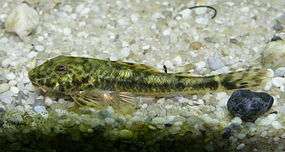Parotocinclus
| Parotocinclus | |
|---|---|
 | |
| Parotocinclus jumbo | |
| Scientific classification | |
| Kingdom: | Animalia |
| Phylum: | Chordata |
| Class: | Actinopterygii |
| Order: | Siluriformes |
| Family: | Loricariidae |
| Subfamily: | Hypoptopomatinae |
| Genus: | Parotocinclus C. H. Eigenmann & R. S. Eigenmann, 1889 |
| Type species | |
| Otocinclus maculicauda Steindachner, 1877 | |
Parotocinclus is a genus of fish in the family Loricariidae native to South America. This genus is distributed through almost all hydrographic systems in South America from the Guyana Shield drainages and Amazon Shield tributaries to the coastal drainages of eastern and southeastern Brazil, including the rio São Francisco basin.[1] Most species have the caudal peduncle oval in cross section.[2] It has been found that Characidium species may interact with P. maculicauda. The small Characidium will follow grazing P. maculicauda, which release particulate matter dislodged from the catfish's foraging.[3]
Taxonomy
By an analysis published in 2005, Parotocinclus is not a monophyletic genus. P. jumbo is not closely related to P. maculicauda, but is positioned, instead, as a basal lineage of the subfamily Hypoptopomatinae. Additionally, P. collinsae is not closely related to Parotocinclus maculicauda and may be more closely related to the genus Hypoptopoma and four other genera. P. jumbo and P. collinsae may eventually be transferred to new genera.[4] P. bidentatus and P. muriaensis form a monophyletic pair of sister taxa that is more closely related to a subset of species of Parotocinclus (which includes P. maculicauda) than to any other genus of the tribe Otothyrini.[4]
Species
There are currently 30 recognized species in this genus:
- Parotocinclus amazonensis Garavello, 1977
- Parotocinclus arandai Sarmento-Soares, Lehmann A. & Martins-Pinheiro, 2009
- Parotocinclus aripuanensis Garavello, 1988
- Parotocinclus bahiensis (A. Miranda-Ribeiro, 1918)
- Parotocinclus bidentatus Gauger & Buckup, 2005
- Parotocinclus britskii Boeseman, 1974
- Parotocinclus cearensis Garavello, 1977
- Parotocinclus cesarpintoi P. Miranda-Ribeiro, 1939
- Parotocinclus collinsae Schmidt & Ferraris, 1985
- Parotocinclus cristatus Garavello, 1977
- Parotocinclus dani Roxo, G. S. C. Silva & C. de Oliveira, 2016 [1]
- Parotocinclus doceanus (A. Miranda-Ribeiro, 1918)
- Parotocinclus eppleyi Schaefer & Provenzano, 1993
- Parotocinclus halbothi Lehmann A., Lazzarotto & R. E. dos Reis, 2014 [5]
- Parotocinclus haroldoi Garavello, 1988
- Parotocinclus jequi Lehmann A., Koech Braun, E. H. L. Pereira & R. E. dos Reis, 2013 [6]
- Parotocinclus jimi Garavello, 1977
- Parotocinclus jumbo Britski & Garavello, 2002
- Parotocinclus longirostris Garavello, 1988
- Parotocinclus maculicauda (Steindachner, 1877)
- Parotocinclus minutus Garavello, 1977
- Parotocinclus muriaensis Gauger & Buckup, 2005
- Parotocinclus planicauda Garavello & Britski, 2003
- Parotocinclus polyochrus Schaefer, 1988
- Parotocinclus prata A. C. Ribeiro, A. L. A. Melo & E. H. L. Pereira, 2002
- Parotocinclus robustus Lehmann A. & R. E. dos Reis, 2012 [7]
- Parotocinclus seridoensis T. P. A. Ramos, Barros-Neto, Britski & S. M. Q. Lima, 2013 [8]
- Parotocinclus spilosoma (Fowler, 1941)
- Parotocinclus spilurus (Fowler, 1941) [9]
- Parotocinclus variola Lehmann A., Schvambach & R. E. dos Reis, 2015 [10]
References
- 1 2 Roxo, F.F., Silva, G.S.C. & Oliveira, C. (2016): Description of a new species of Parotocinclus (Siluriformes, Hypoptopomatinae) from the rio Tapajós basin. ZooKeys, 634: 125–136.
- ↑ Garavello, J.C. & Britski, H.A. (2003): Parotocinclus planicauda, a new species of the subfamily Hypoptopomatinae from Southeastern Brazil (Ostariophysi: Loricariidae). Brazilian Journal of Biology, 63 (2): 253–260.
- ↑ Leitão, R.P., Caramaschi, É.P. & Zuanon, J. (2007): Following food clouds: feeding association between a minute loricariid and a characidiin species in an Atlantic Forest stream, Southeastern Brazil. Neotropical Ichthyology, 5 (3): 307-310.
- 1 2 Gauger, M.F.W. & Buckup, P.A. (2005): Two new species of Hypoptopomatinae from the rio Paraíba do Sul basin, with comments on the monophyly of Parotocinclus and the Otothyrini (Siluriformes: Loricariidae). Neotropical Ichthyology, 3 (4): 509–518.
- ↑ Lehmann A., P., Lazzarotto, H. & Reis, R.E. (2014): Parotocinclus halbothi, a new species of small armored catfish (Loricariidae: Hypoptopomatinae), from the Trombetas and Marowijne River basins, in Brazil and Suriname. Neotropical Ichthyology, 12 (1): 27–33.
- ↑ Lehmann A., P., Koech Braun, B., Pereira, E.H.L. & Reis, R.E. (2013): A New Species of the Hypoptopomatinae Catfish Parotocinclus (Siluriformes: Loricariidae), from the Headwaters of the Rio Jequitinhonha, Brazil. Copeia, 2013 (3): 435-440.
- ↑ Lehmann A., P. & Reis, R.E. (2012): A new species of Parotocinclus (Siluriformes: Loricariidae) from the upper Rio São Francisco, Brazil. Zootaxa, 3390: 56–64.
- ↑ Ramos, T.P.A., Barros-Neto, L.F., Britski, H.A. & Lima, S.M.Q. (2013): Parotocinclus seridoensis, a new hypoptopomatine catfish (Siluriformes: Loricariidae) from the upper rio Piranhas-Açu basin, northeastern Brazil. Neotropical Ichthyology, 11 (4): 787–796.
- ↑ Ramos, T.P.A., Lehmann A., P., Barros-Neto, L.F. & Lima, S.M.Q. (2016): Redescription of the endangered hypoptopomatine catfish Parotocinclus spilurus (Fowler, 1941) (Siluriformes: Loricariidae) from the upper rio Jaguaribe basin, northeastern Brazil. Neotropical Ichthyology, 14 (1): e150098.
- ↑ Lehmann A., P., Schvambach, L.J. & Reis, R.E. (2015): A new species of the armored catfish Parotocinclus (Loricariidae: Hypoptopomatinae), from the Amazon basin in Colombia. Neotropical Ichthyology, 13 (1): 47–52.